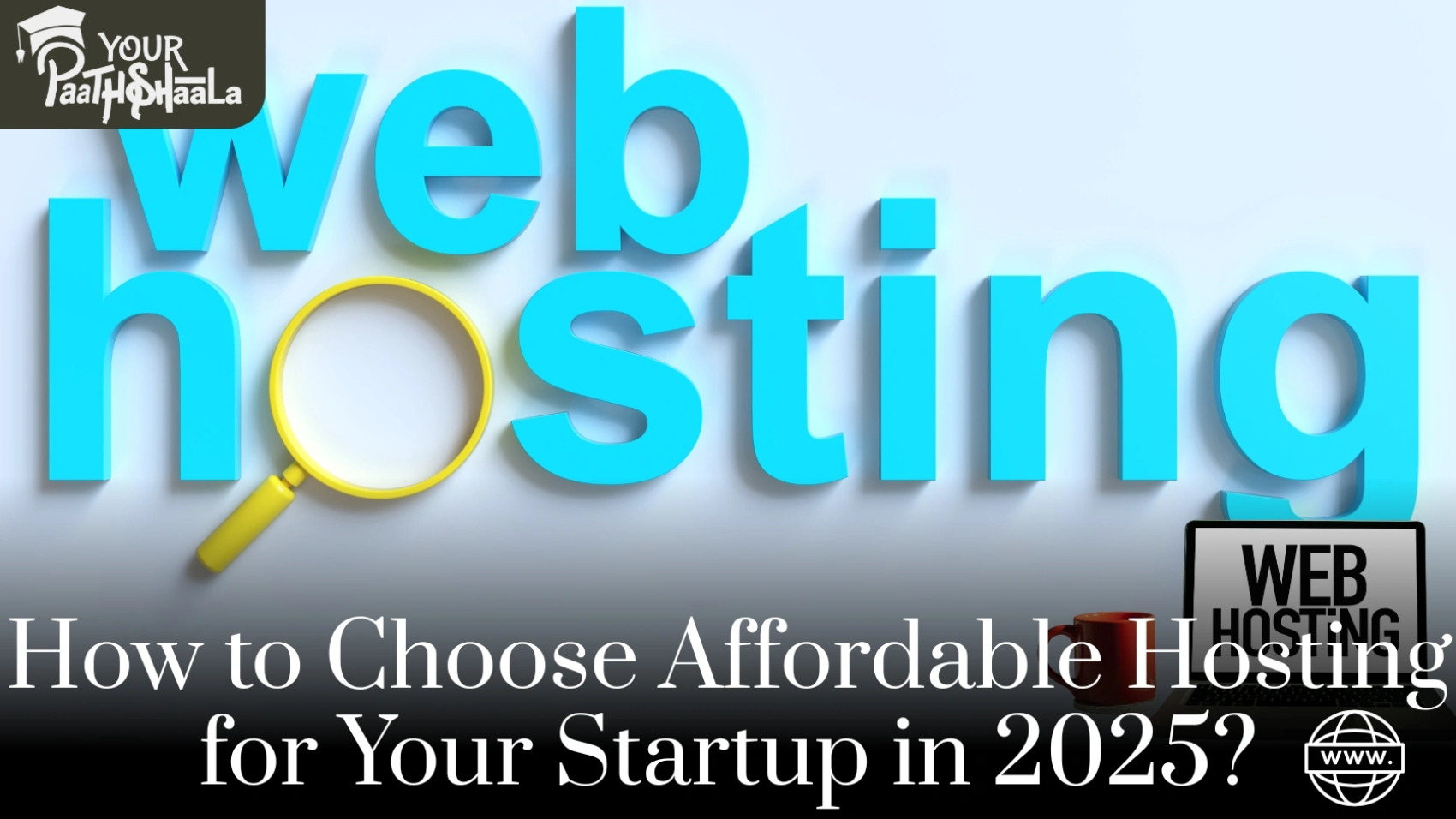Picture a startup founder in Bengaluru launching an e-commerce store, their website loading lightning-fast for customers in Mumbai and Jaipur, all on a budget-friendly hosting plan. In 2025, with 750 million smartphone users driving India’s $188 billion e-commerce market, choosing affordable web hosting is a game-changer for startups. Hosting powers your website, ensuring it’s fast, secure, and accessible, whether you’re selling handicrafts in Chennai or tech services in Hyderabad. For Indian startups, where 90% of traffic comes from mobile devices, picking the right hosting provider balances cost, performance, and local needs like UPI payments.
Fortunately, selecting affordable hosting doesn’t mean sacrificing quality. With the right approach, you can find a provider that fits your budget and boosts your online presence. This guide walks you through how to choose affordable hosting for your startup in 2025, with India-specific tips, free tools, real-world examples, and solutions to common challenges. Plus, we’ll explore future trends to keep your startup competitive. Ready to get your website online? Let’s dive in!
What Is Web Hosting?
Web hosting is a service that stores your website’s files on a server, making them accessible online. Think of it as renting space on the internet for your startup’s digital storefront. For example, when a customer visits “myshop.in,” the hosting server delivers your site’s content instantly. Hosting types include:
- Shared Hosting: Multiple websites share a server, ideal for startups due to low costs (₹59–₹149/month).
- VPS Hosting: A virtual private server offers dedicated resources for growing sites.
- Cloud Hosting: Multiple servers ensure uptime, perfect for e-commerce.
- Dedicated Hosting: A full server for high-traffic sites, pricier but powerful.
For instance, a Mumbai startup used shared hosting to launch a blog for ₹89/month, saving ₹5,000 annually. Affordable hosting ensures your site runs smoothly without breaking the bank.
Why Affordable Hosting Matters for Your Startup
In 2025, choosing the right hosting is critical for Indian startups. Here’s why:
- Budget-Friendly Growth: Affordable plans (₹59–₹300/month) save costs for cash-strapped startups.
- Mobile-First Performance: 90% of India’s traffic is mobile, requiring fast load times for SEO and UX.
- E-Commerce Edge: Hosting with UPI integration supports a $188 billion market.
- Scalability: Affordable plans scale as your startup grows, avoiding upfront costs.
- SEO Benefits: Fast, reliable hosting boosts Google rankings by 15%, per Forbes.
For example, startups with reliable hosting see 25% lower bounce rates and 30% higher engagement, per WebEngage. Therefore, smart hosting choices fuel your startup’s success.
Step-by-Step Guide to Choosing Affordable Hosting
Follow these beginner-friendly steps to select affordable hosting for your Indian startup in 2025. Each step includes practical tips tailored to India’s mobile-first, diverse market.
Step 1: Define Your Startup’s Needs
First, clarify what your website requires to align hosting with your goals.
- Website Type: Is it a blog, e-commerce store, or portfolio? E-commerce needs cloud hosting for traffic spikes.
- Traffic Expectations: Estimate visitors (e.g., 1,000–10,000/month) to choose shared or VPS hosting.
- Budget: Set a limit (e.g., ₹100–₹300/month) for affordability.
- Features: Prioritize free SSL, UPI payments, or Hindi support for Indian users.
For instance, a Delhi startup chose shared hosting for a blog expecting 2,000 monthly visitors, saving ₹3,000/year. Defining needs ensures you don’t overpay for unused features.
Tool: Use Google Sheets to list requirements and compare providers.
Step 2: Research Hosting Providers
Next, explore providers offering affordable plans for Indian startups. Focus on those with local data centers and budget-friendly features.
- Check Local Servers: Providers like BigRock or HostingRaja have Indian data centers for faster load times.
- Compare Plans: Look for shared hosting under ₹150/month with free SSL and domains.
- Read Reviews: Check user feedback on X for real-world insights, like @NGCTech praising Hostinger’s affordability.
For example, a Pune startup shortlisted Hostinger after X posts highlighted its ₹89/month plans and UPI support. Research helps you find reliable, low-cost options.
Tool: Browse X or Trustpilot for user reviews; compare plans on GeeksforGeeks.
Step 3: Evaluate Key Features
Now, assess hosting features to ensure performance and value. Key features for startups include:
- Uptime Guarantee: Look for 99.9% uptime, like MilesWeb’s promise, for reliability.
- Speed: SSD storage and Indian servers (e.g., BigRock) ensure sub-2-second load times.
- Security: Free SSL, malware scans, and DDoS protection (e.g., Hostinger) are must-haves.
- Scalability: Plans should upgrade easily, like Cloudways’ flexible VPS options.
- Support: 24/7 support in Hindi or Tamil, as offered by HostingRaja, aids beginners.
For instance, a Hyderabad startup chose Namecheap for its ₹166/month plan with free SSL and SSD storage. Features like these boost performance without hiking costs.
Tip: Prioritize free migration and website builders for easy setup.
Step 4: Compare Pricing and Discounts
Then, compare pricing to maximize savings. Many providers offer introductory discounts but raise renewal rates.
- Check Introductory Rates: Hostinger’s plans start at ₹89/month for a 3-year term.
- Beware Renewal Costs: BigRock’s ₹149/month plan renews at ₹199/month after three years.
- Look for Freebies: FastComet offers free domains (.online, .site) with hosting.
- Use Promo Codes: Search X for codes like Namecheap’s HOST25TSJUL for up to 67% off.
For example, a Jaipur startup saved ₹2,000 using Hostinger’s 3-year plan at ₹89/month. Long-term plans and discounts keep hosting affordable.
Tool: Use Kripesh Adwani’s hosting reviews for 2025 pricing insights.
Step 5: Test Performance and Support
Before committing, test the provider’s performance and support to ensure reliability.
- Speed Tests: Use Pingdom to check load times on Indian servers (aim for <1.5 seconds).
- Support Response: Contact support via chat or email to test responsiveness, like MilesWeb’s 24/7 Hindi support.
- Money-Back Guarantee: Choose providers like BigRock with 30-day refunds for risk-free trials.
For instance, a Kolkata startup tested HostGator’s Indian servers, achieving 1.2-second load times, and confirmed support via chat in Hindi. Testing prevents costly mistakes.
Tool: Pingdom for speed tests; BrowserStack for mobile compatibility.
Step 6: Set Up Your Hosting
Once you’ve chosen a provider, set up your hosting to launch your site.
- Purchase Plan: Select a shared hosting plan (e.g., MilesWeb at ₹59/month) and pay via UPI.
- Link Domain: Connect your domain (e.g., “myshop.in”) using DNS settings in cPanel.
- Install CMS: Use 1-click installers (e.g., Softaculous) for WordPress or WooCommerce.
- Enable SSL: Activate free SSL for secure HTTPS, boosting SEO by 10%, per Google.
For example, a Chennai startup set up a WooCommerce store on HostingRaja for ₹85/month, integrating UPI in an hour. Setup is quick with user-friendly tools.
Tool: cPanel or hPanel (Hostinger) for easy management.
Step 7: Monitor and Scale
Finally, monitor your hosting and scale as your startup grows.
- Track Performance: Use Pingdom to monitor uptime and speed monthly.
- Upgrade Plans: Switch to VPS or cloud hosting (e.g., Cloudways) for traffic spikes.
- Maintain Security: Ensure malware scans and backups, like Host.co.in’s daily backups.
- Renew Wisely: Budget for renewals to avoid price hikes.
For instance, a Surat startup scaled from Hostinger’s shared to VPS hosting after hitting 10,000 monthly visitors, maintaining costs at ₹699/month. Monitoring keeps your site reliable.
Tool: Cloudflare for free DNS and security enhancements.
Challenges and Solutions
Choosing hosting in India has hurdles, but these solutions help:
- High Renewal Costs: Introductory rates jump at renewal. Solution: Lock in 3-year plans for savings, like BigRock’s ₹149/month.
- Technical Complexity: Beginners struggle with setup. Solution: Use Hostinger or Wix for automated tools.
- Slow Speeds: Non-Indian servers cause lag. Solution: Choose providers with Indian data centers, like HostingRaja.
- Limited Support: Some providers lack local language support. Solution: Pick HostingRaja or MilesWeb for Hindi/Tamil assistance.
For example, startups using Indian servers gain 20% faster load times, per GeeksforGeeks. These strategies ensure affordability and performance.
Future Trends for Hosting in 2025
Looking ahead, hosting trends will shape Indian startups:
- AI-Optimized Hosting: Hostinger’s AI tools auto-optimize sites for speed.
- Voice Search Support: Hosting for voice-friendly sites aligns with 40% of Indian users using voice search.
- Green Hosting: Providers like GreenGeeks offer eco-friendly plans, planting one tree per account.
- Hyper-Local Servers: More providers will add Tier-II city servers (e.g., Lucknow) for low latency.
- Blockchain Hosting: Decentralized hosting emerges for secure startups.
Consequently, by 2027, 70% of Indian startups will use AI-enhanced hosting, per Forbes. Staying updated keeps your site competitive.
Getting Started with Affordable Hosting
Ready to choose affordable hosting for your startup? Here’s a quick recap:
- Define Needs: Identify website type, traffic, and budget.
- Research Providers: Shortlist those with Indian servers and reviews.
- Evaluate Features: Prioritize uptime, speed, security, and support.
- Compare Pricing: Look for discounts and freebies like SSL.
- Test Performance: Check speed and support before buying.
- Set Up Hosting: Link domain, install CMS, and enable SSL.
- Monitor and Scale: Track performance and upgrade as needed.
For example, a Kochi startup chose Hostinger’s ₹89/month plan, launched a seafood store, and earned ₹30,000 in sales within a month. Start small, grow big!
Tip: Begin with Hostinger or BigRock for budget plans with Indian servers.
Conclusion
In 2025, choosing affordable hosting for your Indian startup is a smart way to launch a fast, secure website in a 750 million-user smartphone market. With providers like Hostinger, BigRock, and HostingRaja offering plans from ₹59/month, you can save 15–20% on costs while boosting engagement by 30%. By prioritizing Indian servers, free SSL, and UPI-friendly platforms, your startup can thrive in a $188 billion e-commerce landscape. Moreover, challenges like renewal costs and technical setup are manageable with long-term plans and user-friendly tools. With AI, green hosting, and hyper-local servers shaping the future, now’s the time to act. Choose your hosting today and build a website that shines. What’s your startup’s hosting plan for 2025? Share below and let’s make it happen! At Bestdigitalmarketingcourseinraipur you will learn a lot about digtital marketing and related topics.








